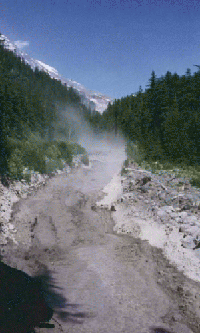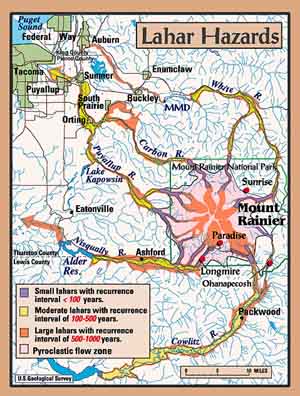

Hazards That Could
Occur
Independent Of An Eruption
Most people associate volcanic eruptions with lava flow and great plumes of ash, and even though these things would cause damage and panic, there are other hazards which, Mount Rainier has the capability of producing that could cause large-scale devastation in the absence of an eruption. A few of these hazards that represent some of the greatest threats from Mount Rainier, are sector collapse, glacial outburst floods, and lahars. Unfortunately these types of hazards are almost impossible to predict and could affect a greater number of people than some of the hazards associated with an eruption.
Sector collapse, or edifice failure, is the collapse of a portion of the volcano. This is often due to earthquakes, rising magma, and abundant precipitation in combination with high relief, steep slopes, and unstable or altered rock. Sector collapse often creates lateral blasts or far-traveling lahars(debris flows). As far as Mount Rainier is concerned, it has all the necessary ingredients for a sector collapse.
Glacial outburst flood, is a hydrological phenomenon that refers to the sudden release of water stored in glaciers. At Mount Rainier, these floods would be a serious threat to the river valleys and could create flooding greater than that of a 100-year flood. This is why glacial outburst flooding is one of the greatest hazards associated with Mount Rainier. This hazard is one of the main reasons that Mount Rainier was included in the decade volcano studies. Major glaciers of Mount Rainier.
Lahar, also known as debris flow is an Indonesian word used by geologists to describe a mudflow or a water-saturated debris flow on a volcano. Lahars are powerful forces that are capable of moving vast amounts of debris, for long distances in a rather short period of time. These flows look and behave like flowing concrete and virtually destroy or incorporate everything in their path. Lahars can range from a few meters thick to hundreds of meters thick. The topography of the land plays a big role in the direction the lahar will go, so regions located at the base of volcano valleys are subject to extreme danger.
Lahars normally develop from volcanic eruptions, sector collapse, and glacial melting but can also be triggered by earthquakes, intense rainstorms, and steam explosions. Unfortunately for all those who live in it's shadow all of these possibilities exist on the steep slopes of Mount Rainier. And of all the risks associated with Mount Rainier, the threat of lahars is certainly the greatest.


Lahar at Tahoma Creek from Mount Rainier.